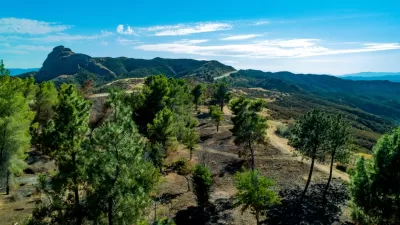Post-fire analysis of the Eaton Fire reveals that a landscape approach — including fire-resistant vegetation, home hardening, and strategic planning — can help reduce wildfire risk, challenging assumptions that trees and plants are primary fire hazards.

The Eaton Fire in Altadena, California, highlights the growing threat of wildfires in the Wildland Urban Interface (WUI) due to climate change and inadequate infrastructure. As Ronnie Siegel explains in this article, while initial assumptions often blame vegetation, post-fire evidence suggests trees and plants were not the primary culprits in the fire's spread—in fact, many served as protective barriers. A landscape-based approach to wildfire risk reduction involves limiting new development in the WUI, creating vegetated buffer zones, and making urban areas more fire-resistant through "home hardening" and updated land-use planning strategies. These measures, when implemented at both the individual and community levels, can help minimize future fire damage.
The Eaton Fire, fueled by drought-stricken chaparral and extreme Santa Ana winds, was likely ignited by a spark from power lines and rapidly spread via wind-driven embers. Thousands of homes burned, largely due to their flammability and close proximity to one another, overwhelming the region’s water supply and firefighting resources. Yet, in many places, native and well-watered trees — such as oaks and deodars — survived and even shielded homes from embers. Observations and LiDAR imaging suggest that fire-adapted and water-retentive plants, both native and non-native, can provide significant protection, challenging current defensible space guidelines that label many of these species as hazards.
Moving forward, experts recommend revisiting and updating these guidelines using on-the-ground data and further research into plant water retention and fire resistance. Collaboration among scientists, fire professionals, planners, and residents will be essential to determine the most effective plant species, landscape designs, and urban green buffer zones. Satellite imagery and post-fire mapping also indicate that urban vegetation — if properly maintained and irrigated — can slow wildfire spread and protect communities. By integrating fire science with landscape planning, we can build more resilient neighborhoods and reduce the risk of future wildfire disasters.
FULL STORY: With a Landscape Approach, We Can Reduce the Risk of the Next Wildfire Disaster

Maui's Vacation Rental Debate Turns Ugly
Verbal attacks, misinformation campaigns and fistfights plague a high-stakes debate to convert thousands of vacation rentals into long-term housing.

Planetizen Federal Action Tracker
A weekly monitor of how Trump’s orders and actions are impacting planners and planning in America.

In Urban Planning, AI Prompting Could be the New Design Thinking
Creativity has long been key to great urban design. What if we see AI as our new creative partner?

How Trump's HUD Budget Proposal Would Harm Homelessness Response
Experts say the change to the HUD budget would make it more difficult to identify people who are homeless and connect them with services, and to prevent homelessness.

The Vast Potential of the Right-of-Way
One writer argues that the space between two building faces is the most important element of the built environment.

Florida Seniors Face Rising Homelessness Risk
High housing costs are pushing more seniors, many of them on a fixed income, into homelessness.
Urban Design for Planners 1: Software Tools
This six-course series explores essential urban design concepts using open source software and equips planners with the tools they need to participate fully in the urban design process.
Planning for Universal Design
Learn the tools for implementing Universal Design in planning regulations.
Gallatin County Department of Planning & Community Development
Heyer Gruel & Associates PA
JM Goldson LLC
City of Camden Redevelopment Agency
City of Astoria
Transportation Research & Education Center (TREC) at Portland State University
Jefferson Parish Government
Camden Redevelopment Agency
City of Claremont





























